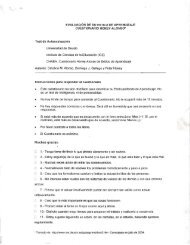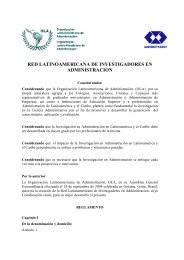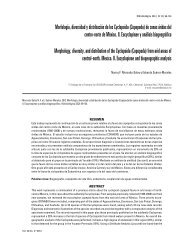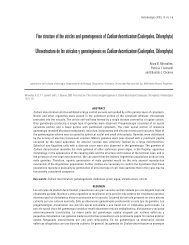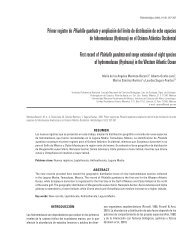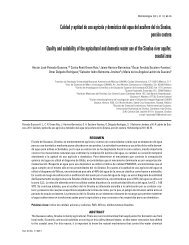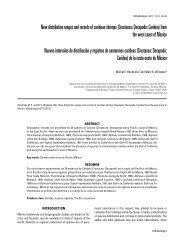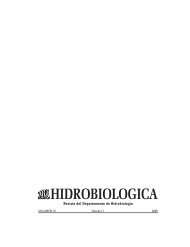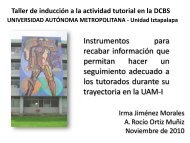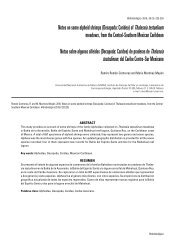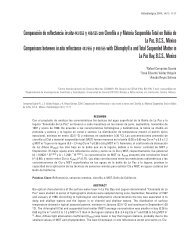LCD pixel shape and far field diffraction patterns - Páginas de ...
LCD pixel shape and far field diffraction patterns - Páginas de ...
LCD pixel shape and far field diffraction patterns - Páginas de ...
You also want an ePaper? Increase the reach of your titles
YUMPU automatically turns print PDFs into web optimized ePapers that Google loves.
266ARTICLE IN PRESSM. Fernán<strong>de</strong>z Guasti et al. / Optik 116 (2005) 265–269record the <strong>diffraction</strong> <strong>patterns</strong> are also <strong>de</strong>scribed in thissection. In Section 3, the experimental layout of one ormore <strong>pixel</strong>s produced by a <strong>LCD</strong> mask is presented. InSection 4, the experimental results are exposed <strong>and</strong> theirmain features discussed. The <strong>shape</strong> of the <strong>LCD</strong> <strong>pixel</strong> isinferred from its <strong>diffraction</strong> pattern through comparisonwith the computer-generated apertures. The <strong>LCD</strong>aperture used in a PDI, rather than the i<strong>de</strong>al circularsymmetry, has the <strong>shape</strong> of a square with blunt corners.The conclusions are drawn in Section 5.2. Photographic masksIntermediate figures between a circle <strong>and</strong> a squaremay be <strong>de</strong>scribed analytically through a single equationrestricted to the appropriate domain [6]. The aperturesproduced with this algorithm yield figures that resemblesquares with blunt corners. These silhouettes may bea<strong>de</strong>quate for mo<strong>de</strong>ling the <strong>shape</strong> of <strong>pixel</strong>s produced bydiverse digital imaging systems. This assertion will, infact, be supported by the results presented hereafter.The photographic diffracting apertures employed in thiswork were generated from the squircle equation, that is,the equation for a square/circular aperture. The polarequation for a squircle form is given bys 2 4 sin2 ð2yÞr 4 k 2 r 2 þ k 4 ¼ 0, (1)where ðr; yÞ are the polar coordinates at the apertureplane <strong>and</strong> ‘‘s’’ is the squareness parameter [6]; s ¼ 1represents a square with si<strong>de</strong>s equal to2k; while s ¼ 0represents a circle of radius k. The equation for thesquare is perhaps more clearly visualized in Cartesiancoordinates with the substitution 4x 2 y 2 ¼ r 4 sin 2 ð2yÞ:The Cartesian equation for a squircle iss 2 x2 y 2 x 2k 2 k 2 k 2 þ y2k 2þ 1 ¼ 0. (2)This expression may be factored for s ¼ 1 into ð1x 2 =k 2 Þð1 y 2 =k 2 Þ¼0; which yields a square when therestriction x 2 ; y 2 pk 2 is imposed. The parameter ‘‘s’’ is agood measure of how sharp or blunt are the corners ofthe square. This parameter may be continuously variedto smoothly change the <strong>shape</strong> of the contour from acircle toa square. The change in the aperture <strong>shape</strong> ismore sensitive when ‘‘s’’ is close to one. A typicalcomputer-generated aperture plot for s ¼ 0:9 is shown inFig. 1. The area lying outsi<strong>de</strong> the curve was ren<strong>de</strong>red inblack in or<strong>de</strong>r to produce the aperture mask. The plotsof the squircle equation for various squareness valueswere recor<strong>de</strong>d in high-contrast photographic film reducingtheir size toabout 1 mm in diameter, that is k ¼0:5mm: The upper left-h<strong>and</strong> quadrant of the diffractingapertures was photographed with an optical microscopein or<strong>de</strong>r to monitor the actual <strong>shape</strong> of the apertures.Fig. 1. Diffracting aperture plot for squareness parameter s ¼0:9:The form of the aperture in the other three quadrants issymmetrical with respect tothe quadrant shown in themicrophotographs.The apertures were illuminated directly with a HeNelaser placed 2 m apart from the aperture plane. The<strong>diffraction</strong> <strong>patterns</strong> were recor<strong>de</strong>d on high-resolutioncolor film located 3 m apart from the diffractingapertures. This distance was appropriate in or<strong>de</strong>r toconsi<strong>de</strong>r the pattern tobe in the <strong>far</strong> <strong>field</strong> <strong>and</strong> alsotofillreasonably well the 35 mm film that was used tophotograph these <strong>patterns</strong>. This simple arrangementwas favored in or<strong>de</strong>r to avoid contributions fromintermediate optical elements.3. Experimental setupThe experimental setup used toobtain the images <strong>and</strong><strong>diffraction</strong> <strong>patterns</strong> of the <strong>LCD</strong> <strong>pixel</strong>s is shown in Fig. 2.The display is a monochrome active matrix twistednematic crystal consisting of an array of 320 240<strong>pixel</strong>s with maximum contrast ratio of 80 to 1 (Kopin,CyberDisplay 320). The <strong>pixel</strong> dimensions given in thespecifications is 15 mm 15 mm <strong>and</strong> the separationbetween <strong>pixel</strong>s is 25 mm: This display was controlledwith a personal computer. The screen resolution wasadjusted so that individual <strong>pixel</strong>s could be turned on(full transparency) or off (fully darkened). The displaywas mounted on an xyz mount <strong>and</strong> placed in the vicinityof the beam waist where it is commonly positioned in aPDI scheme.Images of the open <strong>pixel</strong>s were taken using a travelingmicroscope <strong>and</strong> white light illumination. These imageswere used to confirm the position <strong>and</strong> the number ofactive <strong>pixel</strong>s. The <strong>diffraction</strong> <strong>patterns</strong> of the <strong>pixel</strong>s weretaken un<strong>de</strong>r HeNe laser illumination. The laser beamwas spatially filtered <strong>and</strong> collimated following the usuallayout of a PDI. The image was <strong>de</strong>tected with a CCD
ARTICLE IN PRESSM. Fernán<strong>de</strong>z Guasti et al. / Optik 116 (2005) 265–269 267Fig. 2. Experimental setup. <strong>LCD</strong> is the liquid crystal displaydiffracting aperture. The <strong>diffraction</strong> pattern is observed via acharged-coupled <strong>de</strong>vice (CCD). The microscope <strong>and</strong> the whitelight source (WLS) are used in or<strong>de</strong>r to observe the <strong>pixel</strong>sdirectly but are removed when the <strong>diffraction</strong> pattern isrecor<strong>de</strong>d.placed instead of the microscope 50 cm after the <strong>LCD</strong>plane. A second computer was used to acquire the CCDimage.4. ResultsThe computer-generated aperture <strong>shape</strong>s togetherwith their corresponding <strong>diffraction</strong> <strong>patterns</strong> are shownin Figs. 3a–e. The microscope photographs of theapertures reveal that their <strong>shape</strong> is not as smooth asthe original plots. This raggedness is likely to be due tothe grain of the photographic film. The larger the size ofthe apertures the smaller is the relative effect of the filmgrain; however, the <strong>diffraction</strong> <strong>patterns</strong> become correspondinglysmaller <strong>and</strong> a compromise has to beestablished.The <strong>diffraction</strong> <strong>patterns</strong> were photographed usingdifferent exposure times. Short times reveal the intensitydistribution of the central lobe but higher or<strong>de</strong>rs are not<strong>de</strong>tected whereas longer times saturate the central lobewhile higher or<strong>de</strong>rs are recor<strong>de</strong>d. Diffraction <strong>patterns</strong>are usually difficult tophotograph due tothe large rangeof intensities that need to be recor<strong>de</strong>d. A compromise isrequired in or<strong>de</strong>r to observe the <strong>de</strong>sired features in theregion where the film exhibits a linear response.Digitizing the images is not of great help since it isdifficult tomaintain linear relationships between theneutral <strong>de</strong>nsity of the film <strong>and</strong> the inci<strong>de</strong>nt intensity.The sequence in Figs. 3a–e shows how the initialSincðxÞSincðyÞ <strong>diffraction</strong> pattern of a square is modifiedin various steps of the squareness parameter. Thesecond-or<strong>de</strong>r maxima in each figure illustrate mostclearly the evolution of the sequence. The four lobesaround the central maximum obtained for the squareaperture, merge into one another in the subsequentfigures until one has a squarish ring with uneven butfinite intensity for all angles as may be seen in Fig. 3c.Fig. 3. (a) s ¼ 1:0 – on the left a microphotograph of the upperleft-h<strong>and</strong> corner of the aperture is shown. The right-h<strong>and</strong> si<strong>de</strong>shows a photograph of the <strong>far</strong>-<strong>field</strong> <strong>diffraction</strong> patternproduced by the aperture; (b) s ¼ 0:995 – a small <strong>de</strong>partureof the squareness parameter already reveals an appreciableroundness of the corner of the square; (c) s ¼ 0:9 – thesecondary maxima in the <strong>diffraction</strong> pattern begin to spreadout <strong>and</strong> commence to ‘‘touch’’ each other; (d) s ¼ 0:8 – thesecondary maximum is clearly a ring although it still exhibitslobes reminiscent of the square aperture <strong>and</strong> (e) s ¼ 0:001 – theAiry pattern corresponding to a circle is obtained. Thesecondary maximum is a ring with circular symmetry.The <strong>shape</strong> of the rings come closer to a circular contouras the aperture approaches the circular form. Simultaneously,the intensity distribution as a function of anglebecomes more smooth. Airy rings are obtained in Fig. 3ethat correspond to the <strong>diffraction</strong> pattern of a circle.These features are in qualitative accordance with thenumerical estimates obtained from the Fourier Besselintegrals [1]. Fig. 4 shows a representative contour plot<strong>and</strong> mesh that evaluate the Fourier Bessel transform ofthe wave amplitu<strong>de</strong> in the <strong>far</strong>-<strong>field</strong> limit.It should be noted that higher-or<strong>de</strong>r rings show anunequal intensity as a function of the angle even for thecircular aperture. This irregular behavior is presumablydue tothe raggedness of the aperture. Higher spatial
268ARTICLE IN PRESSM. Fernán<strong>de</strong>z Guasti et al. / Optik 116 (2005) 265–269Fig. 4. Diffraction pattern of squircle with s ¼ 0:9; contourplot for iso-amplitu<strong>de</strong>s shown on the top <strong>and</strong> 3D mesh withheight representing the <strong>field</strong> amplitu<strong>de</strong> on the bottom.Fig. 5. Image of a single <strong>LCD</strong> <strong>pixel</strong> (top) <strong>and</strong> the corresponding<strong>diffraction</strong> pattern in the <strong>far</strong> <strong>field</strong> (bottom).frequencies on the aperture have stronger influence onhigher-or<strong>de</strong>r rings or further away from the axis in the<strong>diffraction</strong> pattern [7].Let us now exhibit the images <strong>and</strong> <strong>diffraction</strong> <strong>patterns</strong>obtained with the <strong>LCD</strong> mask. The microscope image ofa single <strong>LCD</strong> <strong>pixel</strong> together with its <strong>far</strong>-<strong>field</strong> <strong>diffraction</strong>pattern is shown in Fig. 5. The low resolution of thetraveling microscope yields an image whose squarish<strong>shape</strong> may only be approximately guessed from thephotograph. However, comparison of the <strong>diffraction</strong>pattern of the <strong>pixel</strong> with the previous <strong>patterns</strong> showsthat the <strong>pixel</strong> is not a perfect square with sharp corners.The most similar <strong>diffraction</strong> image is 3c, which indicatesthat the <strong>pixel</strong> has blunt corners with a squarenessparameter around s ¼ 0:9: The reference wavefront in aPDI will have this pattern when implemented with an<strong>LCD</strong> <strong>pixel</strong> of this type. Departure from the point sourcecircular symmetry is expected even if only the centralportion is consi<strong>de</strong>red as may be seen from the contourplot in Fig. 4. This discrepancy with the sphericalwavefront should then be taken into account so that it isnot associated, for example, with aberrations of anoptical system un<strong>de</strong>r test.In Fig. 6, the image <strong>and</strong> <strong>diffraction</strong> pattern of anarray of nine apertures are shown. The contribution ofthe square <strong>pixel</strong>s blunt corners is still clear in the<strong>diffraction</strong> pattern. On the one h<strong>and</strong>, full rings ratherthan the spots expected from the square array are clearlyvisible. On the other h<strong>and</strong>, the rings are not circular butare flattened at 45 from the Cartesian axes. Furthermore,the rings are more intense in the regions whereperfect squares would exhibit their maxima. The<strong>diffraction</strong> pattern, according to Fourier optics theory,should correspond to the convolution of the single <strong>pixel</strong>aperture that is shifted to the other eight positions in theaperture plane.5. ConclusionsThe <strong>far</strong>-<strong>field</strong> <strong>diffraction</strong> from apertures whose <strong>shape</strong>lies between a square <strong>and</strong> a circle has been experimentallystudied. The main features of the observed<strong>diffraction</strong> <strong>patterns</strong> are qualitatively in accordance withpreviously reported computer simulations. From atopological point of view, these results no longer exhibitthe square <strong>and</strong> the circle as isolated aperture cases but asa continuous <strong>de</strong>formation, which may be tackled withnumerical evaluations that can be qualitatively comparedwith experimental observations.


